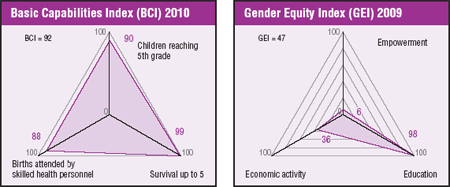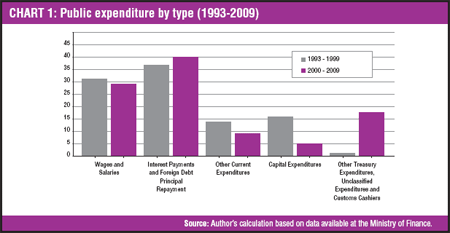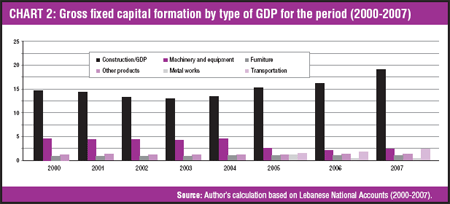A new set of goals is needed
Lebanese Union for People with Disabilities (LPHU)
Rabih Fakhri
Lebanon has one of the highest debt-to-GDP ratios in the world and lacks a comprehensive vision and action plan to increase productivity and efficient resource allocation for pro-poor growth. Since 1992 the post-war financial architecture has combined expansionary reconstruction policies with restrictive monetarist ones, leaving narrow fiscal spaces for socio-economic development. In order to respond to the priorities of reducing poverty and discrimination, a more contextualized set of development goals is needed in which long-term financing for development is part of an overall strategy for growth.
 |
On the tenth anniversary of the Millennium Development Goals (MDGs) they remain a priority for Lebanon. This was reflected by their integration into the Social Action Plan (SAP), a pillar of the economic reform plan submitted by the Government to the Lebanon Donors Conference (LDC) Paris III in 2007. SAP identified social reforms and outlined a variety of interventions such as safety net mechanisms, cash transfers and the overall reform of education and health services. However, although an inter-ministerial committee was established to oversee SAP’s implementation, three years later the plan is in the pilot stage and the committee is inactive due to the political instability.
The latest MDGs report (2008) highlights that Lebanon is on track to fulfil the goals related to education and child and maternal mortality. Yet poverty persists as a serious challenge to development efforts. A recent study found a modest decline in the percentage of people living in extreme poverty from 10% in 1997 to 8.5% in 2007 (although it had dropped to 8% in 2005), while 28.5% are defined as poor. A fifth of the population lives between the lower and upper poverty thresholds.[1]
There is a correlation between poverty and regional disparities, lack of education, gender and unemployment. Findings show that 82% of the extremely poor and 78% of the poor are concentrated in the North, Mount Lebanon and the Bekaa Valley; both the North and Bekaa had the lowest share of per capita nominal expenditure in 2004–2005. One out of five among the poor is illiterate while the average is one out of eight among the better off. The gender gap in education continues, with illiteracy among females twice that among males at 11.8% and 5.6%, respectively.[2]
Unemployment is much more widespread among the poor – 14% compared to 6.7% for the non-poor – with rates of poor unemployed women almost double that of men (26.6% and 13.5% respectively).[3] Unemployment among youth (15-24 years) is another factor that correlates with poverty, since 48.4% of the unemployed are young people.[4] The poor are under-represented among salaried employees; they are most likely to be active in non-waged jobs – two third of the poor are in this situation – which increases their vulnerability.[5]
Development should be rights-based
Rights-based development is needed for people to live decent lives. Lebanese laws remain discriminatory against marginalized groups and gender gaps in policy-making hinder the process of reform. Women still cannot confer their nationality on their children, and other articles of the penal code continue to tolerate “honour crimes” and marital rape.
People with disabilities are another group suffering from systematic discrimination. Half of people with disabilities in Lebanon are illiterate and only 26% of those capable of work are employed.[6] Disability rights advocates continue to lobby for laws that would guarantee their access to education, employment, health and financial assets. As Houda Boukhari has stated, it is not physical impairment but cultural bias that makes the lives of people with disabilities more cumbersome: “In the Lebanese cultural context the birth of a disabled child is seen by many as not only a misfortune, but as shameful and embarrassing.”[7]
The Lebanese financial architecture
Rebuilding the State apparatus and the country’s physical infrastructure was at the core of post-war reconstruction plans implemented in the early 1990s. During the early post-war period of 1992-1997 the macroeconomic model relied heavily on the flow of foreign capital. It is estimated that the direct cost of the first period of reconstruction exceeded USD 4 billion.[8] Lebanese financial authorities adopted a fixed exchange rate policy in order to control inflation; as a result the country over-borrowed in order to accumulate reserves needed to defend its monetary policy and interest rates jumped to previously unknown levels (35% on 12-month treasury bills in 1995).
The growth generated by the reconstruction boom ended abruptly in 1997. Simultaneously, public debt skyrocketed with interest payments accounting for more than the half of State revenues. By 2004 public investment in the State apparatus was 107% of the initially planned investment and in the infrastructure it was 190%. At the same time, the resources allocated to social and productive sectors did not exceed 50% and 90%, respectively, of what was planned.[9]
The Government has sought Official Development Assistance (ODA) as a key factor in sustaining financial stability – debt restructuring, currency appreciation and current State expenditure. In 2002 it was able to collect around USD 10.1 billion during LDC Paris II; later in 2007 an amount of USD 7.5 billion was pledged as foreign aid (grants and soft loans) in LDC Paris III. In the latest progress report – December 2009 – the Ministry of Finance highlighted the receipt of USD 3.7 billion out of USD 5.87 billion agreed. Figures show that over half of these funds go to budget support.
Spending and development
A breakdown of public expenditure shows that debt servicing and public services consumed the bulk of public resources between 1997 and 2006. Yet spending on education and health represented only 15% and 6%, respectively. Furthermore 88% of spending on education went as wages for public servants while 86% of the resources allocated to health financed hospitalization of individuals in private commercial hospitals.[10] Resources allocated for the development of these two sectors were minimal.
 |
The Lebanese taxation system was reformed in early 1990 towards the supply side. The top income tax rate went down from 32% to 10% and taxes on financial companies became a 10% flat rate – with a reduction to 5% for companies involved in construction. The productive sector pays a progressive tax rate of between 3% and 10% on profits.[11] Value added tax (VAT) was introduced in 2001 as a 10% flat rate.
However, rent-based activities such as real estate transactions, banking and financial activities are exempted from VAT, in addition to gambling activities and air transport for goods and persons. A close review of public revenues shows that taxes contributed 67% for the period 2000–2009, with indirect taxes making up the major share. In 2009 indirect taxes represented 75% of overall tax revenues – VAT 32%, gasoline 11%, customs 11% and other 21% – while taxes on profits, wages, gains, interests and real estate registration account for only 25%.
Such a regressive taxation system, together with 10 years of wage freezes and restrictive monetarist policies, has worsened the living conditions of middle- and low-income workers. Wealth concentration increased during this period as the poorest 20% of Lebanese consumed only 7.1 % of total consumption while the richest 20% consumed 43.5%.[12] Some 2% of depositors hold 59% of bank deposits.[13]
Foreign direct investment (FDI)
Between 2000 and 2007 Lebanon attracted important amounts of FDI – for example, 28% of the overall FDI that flowed to the Economic and Social Commission for Western Asia region in 2003 – with the highest FDI-to-GDP ratio.[14] However, FDI is rarely oriented to the real economic sector (in which good and services are produced); instead, real estate, banking and tourism consume most of it (almost 90% in 2007).[15] Construction permits jumped from 9 million square metres in 2007 to 16.1 million in 2008.[16] This correlates with the growth of USD 918 million in the inflow of Arab FDI between 2007 and 2008.[17] Likewise the value of transactions in this sector grew an average of 17.6% per year for the period 2003-2008 (and 54.4% in 2008 alone).[18] Chart 2 shows that most of the gross capital formation in 2000-2007 was generated by the construction sector. However these profits are exempt from taxes.
 |
Concluding remarks
Since Lebanon’s debt-to-GDP ratio (153% in June 2009) is among the highest in the world, it is imperative for a debt management strategy to point the way for ODA to invest in increasing productivity rather than its exclusive use in the debt restructuring process. Also, a dynamic counter-cyclical financial architecture has to be implemented. Government must provide more incentives for FDI to invest in labour-intensive economic activities rather than this being exclusively allocated to real estate and financial activities.
A poverty reduction strategy should go beyond achieving MDG 1. SAP is only a limited, short-term intervention. Development policies have to promote job creation for middle- and low-skilled labour. They have to ensure decent work conditions for the poor – in this context waged jobs are still a key factor for poverty reduction. Finally, the structure of taxes has to be reformed towards more direct taxes on profits generated out of transactions in real estate and the financial sector. A more equal taxation system is needed to enhance the re-distributional effect of resources.
[1] Heba Laithy, Khalid Abu-Ismail and Kamal Hamdan, Poverty, Growth and Income Distribution in Lebanon (Brasilia, Brazil: International Poverty Centre, 2008). Available from: <www.ipc-undp.org/pub/IPCCountryStudy13.pdf>.
[2] Ibid.
[3] Ibid.
[4] UNDP Lebanon, Millennium Development Goals Report 2008: Lebanon, Beirut, 2008. Available from: <www.undp.org.lb/communication/publications/downloads/MDG_en.pdf>.
[5] Ibid.
[6] Data from the Lebanese Physical Handicapped Union.
[7] Houda Boukhari, “Invisible Victims: Working with Mothers of Children with Learning Disabilities,” in Gender and Disability: Women’s Experiences in the Middle East, ed. L. Abu-Habib (Oxford: Oxfam, 1997), 37.
[8] Ghassan Dibeh, Foreign Aid and Economic Development in Postwar Lebanon, United Nations University – WIDER Research Paper No. 2007/37, June 2007. Available from: <www.works.bepress.com/cgi/viewcontent.cgi?article=1001&context=ghassan_dibeh>.
[9] Ghassan Dibeh, The Political Economy of Postwar Reconstruction in Lebanon, United Nations University – WIDER Research Paper No. 2005/44 , July 2005. Available from: <www.works.bepress.com/cgi/viewcontent.cgi?article=1000&context=ghassan_dibeh>.
[10] R. Fakhri, Efficiency of public expenditures in Lebanon and other transitional democracies, Beirut, 2010.
[11] Wassim Shahin, “The Lebanese Economy in the 21st Century,” in Lebanon’s Second Republic, ed.K. Ellis (Gainesville, FL: University Press of Florida, 2002).
[12] Laithy et al., op. cit.
[13] Fafo, Ministry of Social Affairs and UNDP, “Al-Wadeh Al-Iktisadi Al-Ijtimai, Dirassa L Ahwal L Maisha,” 2004, 55–57.
[14] Economic and Social Commission for Western Asia, Foreign Direct Investment Report 2008. Available from: <www.escwa.un.org/information/publications/edit/upload/edgd-08-tech1-e.pdf>.
[15] Investment Development Authority in Lebanon, Advantages of Investing in Lebanon. Available from: <www.slideshare.net/mhdbadr/investing-in-lebanon-new-presentation-restructured-presentation>.
[16] Bank Audi, Lebanon Real Estate Report, July 2009. Available from: <www.menafn.com/updates/research_center/Lebanon/Economic/audi220709e.pdf>.
[17] Ibid.
[18] Ibid.


